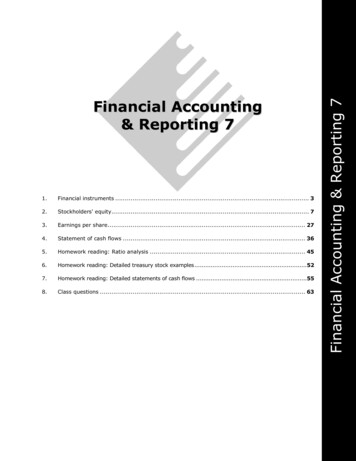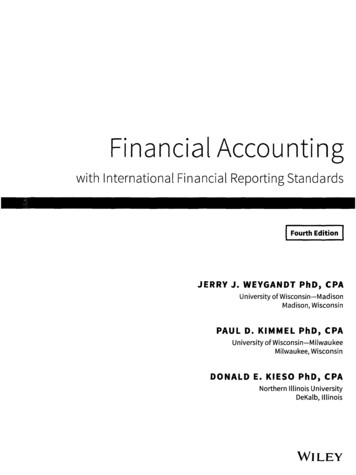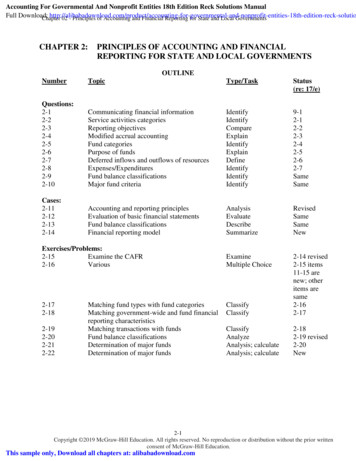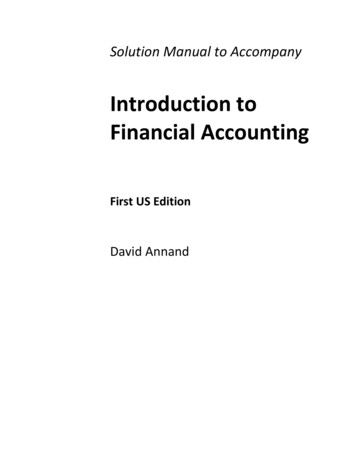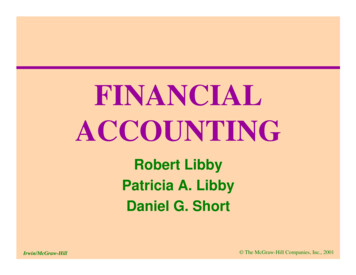
Transcription
Financial Accounting
Financial AccountingAbout the TutorialThis tutorial will help you understand the basics of financial accounting and itsassociated terminologies.AudienceThis tutorial has been designed to help beginners pursuing education in financialaccounting or business management. Any enthusiastic reader with basicmathematics knowledge can comprehend this tutorial. After completing thistutorial, you will find yourself at a moderate level of expertise from where you cantake yourself to next levels.PrerequisitesBefore you start proceeding with this tutorial, we assume that you have a basicunderstanding of commerce.Copyright & Disclaimer Copyright 2014 by Tutorials Point (I) Pvt. Ltd.All the content and graphics published in this e-book are the property of TutorialsPoint (I) Pvt. Ltd. The user of this e-book is prohibited to reuse, retain, copy,distribute or republish any contents or a part of contents of this e-book in anymanner without written consent of the publisher.We strive to update the contents of our website and tutorials as timely and asprecisely as possible, however, the contents may contain inaccuracies or errors.Tutorials Point (I) Pvt. Ltd. provides no guarantee regarding the accuracy,timeliness or completeness of our website or its contents including this tutorial. Ifyou discover any errors on our website or in this tutorial, please notify us atcontact@tutorialspoint.comi
Financial AccountingTable of ContentsAbout the Tutorial . iAudience . iPrerequisites . iCopyright & Disclaimer . iTable of Contents . ii1. OVERVIEW . 1Introduction . 1Definition of Accounting . 1Objectives and Scope of Accounting . 2Accounting Process . 2Accounting Process . 3Accounting Concepts. 5Accounting Conventions . 9Classification of Accounts . 11Accounting Systems . 122. FINANCIAL ACCOUNTING . 15Journal . 15Analysis and Treatment of Transactions . 16Posting in a Ledger . 21Ruling of Account in Ledger Account . 223. SUBSIDIARY BOOKS . 26Cash Book . 26Triple Column Cash Book . 28Petty Cash Book . 28Purchase Book . 28Sale Book . 29ii
Financial AccountingPurchase Return Book . 29Sale Return Book . 29Bills Receivables Book . 30Bills Payable Book . 30Key Features of Subsidiary Books. 30Bank Reconciliation . 31Trial Balance . 32Financial Statements . 33Owner’s Equity . 34Current Assets. 34Current Liabilities . 35Depreciation . 354. COST ACCOUNTING . 38Definition of Cost Accounting . 38Concepts of Cost Accounting . 38Advantages of Cost Accounting . 41Cost Accounting versus Financial Accounting . 43Classification of Cost . 45Elements of Cost . 48Cost Control and Cost Reduction . 49Tools and Techniques of Cost Reduction . 535. COSTING TECHNIQUES . 55Marginal Costing . 55Standard Costing . 57Variance Analysis . 58Cost-Volume-Profit Analysis . 62Break-Even Chart . 65iii
Financial Accounting6. MANAGEMENT ACCOUNTING. 67Definition . 67Characteristics of Management Accounting . 67Objectives of Management Accounting . 69Management Accounting versus Cost Accounting . 71Cash Flow . 727. RATIO ANALYSIS . 83Accounting Ratio . 83Accounting Analysis . 83Ratio Analysis and its Applications . 83Advantages of Ratio Analysis . 84Limitations of Ratio Analysis . 84Types of Ratio . 85Chart of Useful Ratios . 88Working Capital . 948. BUDGETING ANALYSIS. 97Definition . 97Budget, Budgeting, and Budgetary Control . 97Types of Budgets . 98Flexible Budget v/s Fixed Budget . 100Flexible Budget . 101Cash Budget . 102iv
1. OVERVIEWFinancial AccountingThis chapter covers the following topics: Definition of AccountingObjectives & ScopeAccounting ProcessAccounting ConceptsAccounting ConventionsClassification of AccountsSystem of AccountingRules of Double Entry Accounting SystemIntroductionAccounting is a business language. We can use this language to communicate financialtransactions and their results. Accounting is a comprehensive system to collect, analyze, andcommunicate financial information.The origin of accounting is as old as money. In early days, the number of transactions werevery small, so every concerned person could keep the record of transactions during a specificperiod of time. Twenty-three centuries ago, an Indian scholar named Kautilya aliasChanakya introduced the accounting concepts in his book Arthashastra. In his book, hedescribed the art of proper account keeping and methods of checking accounts. Gradually,the field of accounting has undergone remarkable changes in compliance with the changeshappening in the business scenario of the world.A bookkeeper may record financial transactions according to certain accounting principles andstandards and as prescribed by an accountant depending upon the size, nature, volume, andother constraints of a particular organization.With the help of accounting process, we can determine the profit or loss of the business on as
Rules of Double Entry Accounting System Introduction Accounting is a business language. We can use this language to communicate financial transactions and their results. Accounting is a comprehensive system to collect, analyze, and communicate financial information. The origin of accounting is as old as money. In early days, the number of transactions were




